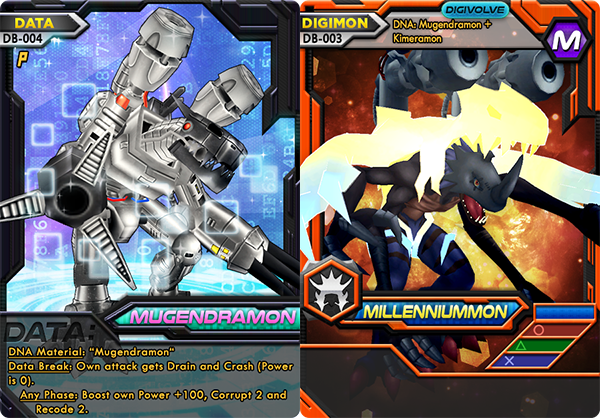How do DATA cards work?
Like any new thing, DATA cards are likely to be confusing at first. The new black border is unfamiliar, and their “timing” text just says “DATA” followed by effects from all kinds of different phases. What’s this all about? Let’s start with their possibilities:
- DATA can be used as a DNA material for the card in their name. A reminder text is included with each, listed as “DNA Material: …..”
- “Data Break” ability involves deleting a specific card from your Destiny Zone, to gain the specified effect(s), as if it were a Mega’s “Activate” ability.
- Each DATA also has a redundancy effect (usually “Any Phase” timing) which lets you get rid of the card in case you don’t want to Data Break during this game, and don’t want to clog your hand either.
- The primary purpose of DATA cards is to expand the current evolution system to include Super-Ultimates like Millenniummon, which often require impossible DNAs and/or previous levels.
- Their secondary purpose is to make certain evolutions more consistent, or provide a nuanced strategy (with their “Data Break” + alternate abilities).
- They are Partnerable for added consistency.
Deck Legality
Great, so how many can you run? After all, they’re not a Digimon, Ace, Firewall, Option, or Evolution card. Here’s are the rules for how DATA cards can be included in your deck:
- A card in your Destiny Zone (i.e. the Level M) must contain the name printed on the DATA card somewhere (Evo-box, or its own card name).
- One copy of a unique DATA card may be run. This means its set# such as “DB-002”, not its name. You could in theory have multiple of the same name.
- You can run as many DATA cards as are legal according to the above points.
- In theory, you could run material DATAs (such as Mugendramon for Millenniummon) and the Level M itself (Millenniummon in this case)
It’s actually quite simple once you get the basic premise down: one copy of something that’s named in your DZ.
Examples of Use

The scenario: You have an active Kimeramon, Mugendramon DATA in hand, and Millenniummon in your Destiny Zone. It’s your Evolution Phase, what can you do?
- You can discard the Mugendramon DATA to DNA evolve to Millenniummon.
- You can skip evolution and Data Break (at any time on your turn) by deleting Millenniummon, to give your attack Crash, Drain, and make the Power 0 (astute readers will note what this references)
- Discard the Mugendramon DATA during any phase to get +100 Power, Corrupt 2 from your opponent’s deck, and Recode 2 your own deck.
- If “Millenniummon DATA” exists as a card, it could legally be in your deck and used as above, especially for Data Break.
- If Mugendramon was your Level M instead: You could Data Break and delete the Mugendramon in your DZ for the Data Break effect.
- “Mugendramon DATA” could instead be the “Partner Option” in your DZ, and your Partner Rookie could stand in for it in the above examples.
Overall, DATA cards are as simple as any other multi-use card. Getting the phases and timing down is what will really set you apart from those who blindly run them with no strategy. Though, they are usually pretty powerful so if you’re a casual player, loading up your deck with as many legal DATA cards as possible won’t usually be a bad idea.
Hopefully, this article explained DATAs, their legality, and their use thoroughly. If you have any questions or comments, please leave them in the comment section below and I’ll address them!

Leave a comment